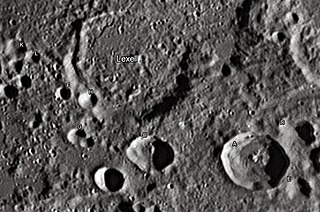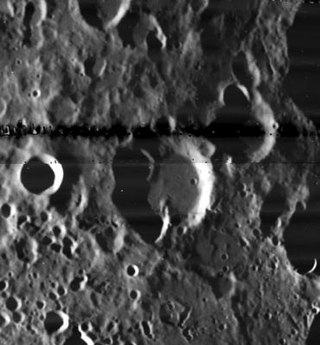
Bayer is a lunar impact crater located in the southwest section of the moon, to the east of the crater Schiller. The rim of Bayer is slightly worn by erosion, but remains well-defined. There is an inner terrace, but the outer wall is intruded upon by nearby impacts. The most significant of these is Schiller H, which forms a ridge attached to the northwest rim of Bayer. The floor of Bayer is relatively flat and lacks a central peak. There is a small, but notable crater on the floor near the western wall. This crater has a breach in its northern rim.

Eddington is the lava-flooded remnant of a lunar impact crater, located on the western part of Oceanus Procellarum. The western rim is attached to the wall of the walled plain Struve. To the east-southeast is the smaller but prominent crater Seleucus. South of Eddington is Krafft.

Aitken is a large lunar impact crater that lies on the far side of the Moon, named for Robert Grant Aitken, an American astronomer specializing in binary stellar systems. It is located to the southeast of the crater Heaviside, and north of the unusual formation Van de Graaff. Attached to the southwest rim is Vertregt. To the southeast is the smaller Bergstrand.

Alhazen is a lunar impact crater that lies near the eastern limb of the Moon's near side. Just to the south-southeast is the crater Hansen, and to the west is the Mare Crisium. The rim of Alhazen is nearly circular, but appears highly oblong when viewed from the Earth due to foreshortening. The inner walls and the crater floor are rugged and irregular. A low ridge joins the south rim of Alhazen with the nearby Hansen. The crater is named after the Arab Muslim scientist, Ibn al-Haytham.

Ctesibius is a small lunar impact crater that is located near the equator, on the far side of the Moon. It is named after the ancient Greek-Egyptian inventor Ctesibius. It lies between the larger crater Abul Wáfa to the west and the slightly smaller Heron to the east.

D'Arrest is a lunar impact crater that is located in the lava-flooded region to the west of the Mare Tranquillitatis. It is named after the German astronomer Heinrich Louis d'Arrest. It lies to the southeast of the crater Agrippa and northwest of Delambre. Just to the northeast are the small, bowl-shaped craters De Morgan and Cayley.

Biela is a lunar impact crater that is located in the rugged highlands of the southeastern Moon. It is named after Austrian astronomer Wilhelm von Biela. The crater lies to the east of Rosenberger, to the southeast of the Watt–Steinheil double crater.

Berzelius is a lunar impact crater located in the northeast part of the Moon's near side. It lies to the southeast of the crater Franklin, and to the northwest of Geminus.

Brunner is a lunar impact crater that is located along the eastern limb of the Moon, to the southeast of the Mare Smythii. At this location the crater is viewed from the edge, and so it is not possible to see much detail from the Earth. The visibility of this formation is also affected by libration. The crater lies to the southwest of the walled plain Hirayama, and to the east of the elongated crater Houtermans.

Cuvier is a lunar impact crater on the southern part of the Moon's near side. It is attached to the east-southeast rim of the unusually shaped formation Heraclitus. To the northeast is the crater Clairaut.

Casatus is a lunar impact crater that is located near the southern limb of the Moon. The north-northeast rim of the crater overlies a portion of the slightly larger crater Klaproth. Along the western rim, Casatus A intrudes somewhat into the interior, producing an inward-bowing rim. To the southeast of Casatus is Newton.

Damoiseau is a lunar impact crater that is located just to the west of the Oceanus Procellarum, in the western part of the Moon's near side. It lies due east of the prominent crater Grimaldi, a walled plain with a distinctive dark floor. Due south of Damoiseau is the crater Sirsalis.

Lexell is a lunar impact crater that lies across the southeastern rim of the huge walled plain Deslandres, in the southern part of the Moon. It was named after Swedish-Russian mathematician and astronomer Anders Johan Lexell. To the northeast is the walled plain Walther, and to the south is Orontius, another walled plain.

Campbell is a large lunar impact crater that is located in the northern hemisphere on the far side of the Moon. It lies to the southwest of the walled plain D'Alembert, an even larger formation. If Campbell were located on the near side of the Moon as seen from the Earth, it would form one of the largest visible craters, being slightly larger than Schickard. It is bordered by several craters of note, with Wiener to the southwest, Von Neumann just to the south, Ley overlying the southeast rim, and Pawsey to the west.

Cichus is a lunar impact crater that lies in the southwestern part of the Moon, at the eastern edge of Palus Epidemiarum. Just to the northeast and nearly contacting the rim is the lava-flooded crater remnant Weiss. The crater is named after Italian astronomer Cecco d'Ascoli.

Chernyshev is a lunar impact crater that is located in the northern part of the Moon's far side. It lies to the northeast of the crater Chandler, and to the southeast of the walled plain D'Alembert.

Congreve is a lunar impact crater that is located on the far side of the Moon relative to the Earth, and lies across the lunar equator. It lies to the west-northwest of the massive walled plain Korolev. To the southeast is the crater Icarus, and due north is Zhukovskiy.

Ricco is a lunar impact crater. It is located in the northern part of the Moon's far side. This crater overlies the southeastern rim of the larger crater Milankovic. Less than one crater diameter to the southwest is Karpinskiy, while to the southeast is Roberts.

Douglass is a lunar impact crater on the far side of the Moon. It lies to the southwest of the crater Frost and south-southwest of the large walled plain Landau.

Fersman is a large lunar impact crater on the Moon's far side. It lies to the east of the crater Poynting, and west-northwest of Weyl. To the south is the huge walled plain Hertzsprung.
























